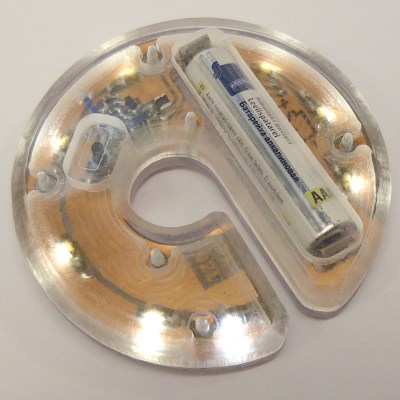[Petteri Aimonen] created an omnidirectional LED safety light to cling to his child’s winter hat in an effort to increase visibility during the dark winter months, but the design is also great example of how to use the Microchip MCP1640 — a regulated DC-DC step-up power supply that can run the LEDs off a single AAA cell. The chip also provides a few neat tricks, like single-button on/off functionality that fully disconnects the load, consuming only 1 µA in standby.
 [Petteri]’s design delivers 3 mA to each of eight surface-mount LEDs (which he says is actually a bit too bright) for a total of about 20 hours from one alkaline AAA cell. The single-layer PCB is encased in a clear acrylic and polycarbonate enclosure to resist moisture. A transistor and a few passives allow a SPST switch to act as an on/off switch: a short press turns the unit on, and a long press of about a second turns it back off.
[Petteri]’s design delivers 3 mA to each of eight surface-mount LEDs (which he says is actually a bit too bright) for a total of about 20 hours from one alkaline AAA cell. The single-layer PCB is encased in a clear acrylic and polycarbonate enclosure to resist moisture. A transistor and a few passives allow a SPST switch to act as an on/off switch: a short press turns the unit on, and a long press of about a second turns it back off.
One side effect is that the “off” functionality will no longer work once the AAA cell drained too badly, but [Petteri] optimistically points out that this could be considered a feature: when the unit can no longer be turned off, it’s time to replace the battery!
The usual way to suck a battery dry is to use a Joule Thief, and while this design also lights LEDs, it offers more features and could be adapted for other uses easily. Interested? [Petteri] offers the schematic, KiCAD file for the PCB, and SVG drawing of the enclosure for download near the bottom of the project page.
















Isn’t this a perfect candidate for a rechargeable battery?
In combo with peltier device stuck to the head…
My thought exactly.
There are AAA sized rechargeable batteries available that would make operating this light cheaper and less wasteful.
This chip operates from voltages as low as 0.35V, and you’re not supposed to discharge AA or AAA NiMH cells below 1V so they’re not really suitable for this purpose.
Less wasteful? What do you want, solar power on it? Jesus it already can use ‘dead’ batteries
Nice! Great way of squeezing some juice from “dead” batteries. Mind that deep discharged batteries may leak.
I like that question buddy
For a multi-KED light a Joule Thief circuit in one of its many variants might be better. Or a RCC circuit. And the fact that power switch stops operating when voltage is too low makes this circuit not that well suited to use batteries.
I don’t believe the Joule thief can approach the efficiency of these boost IC’s. Show me where someone has a measured efficiency of over 80% and I’ll take notice.
Seems like a LDR or photodiode to detect ambient light and auto-power-off would be helpful.
I actually did this years ago; LDR in a resistor divider with a 10k pot, driving a 74HC14 inverting Schmitt trigger, which then drove a P-channel MOSFET to switch power to the LEDs. The whole thing was mounted in a full-brim hard hat with 1W “high-beam” and 3 “low-beam” LEDs; an 12 red warning LEDs around the rim driven by two more 74HC14 circuits (one as a pierce oscillator, the other just inverting the output of the oscillator).
I could switch any of the 3 LED banks between off, auto or on as needed, and the moment I stepped inside into the light, it automatically shut off unless I manually overrode it.
The MCP1640 looks like it’d be a worthy upgrade to that concept though.
https://stuartl.longlandclan.id.au/blog/2007/09/05/hatlamp/
How about cycling through the LEDs, which would leave only one on at a time?
Yeah, for NiMH batteries it would be better to have a higher cut-off voltage.
I find that NiMH batteries perform quite poorly in practice, and didn’t feel comfortable using Li-ion for this purpose.
The physical/mechanical design is beautiful. The clip-on-the-hat is perfect.
This looks like something that IKEA would come up with. (And I hope you interpret that correctly as praise.)
Especially in the winter, when you need a light like that, a NiMH will have almost no usable capacity. A NiCd would be perfect for that, but they are no longer available. I’m also not a fan of disposable batteries and I’m using rechargeable ones whenever I can, but sometimes they just don’t work.
Is there any equivalent with 1.5v and 3.3v output?
batteries on the head of a kid are always heavy, so the idea is not ok.,
It’s a single AAA. Weighs about 10g. Stop being ridiculous.
When I read the title I thought it was for my Pi to stop my code from crashing or summat…
Or summat. Sounds like yr frum raand ere
Seeing recent explorations of PCB traces as heaters, antennas, and even motors, I’m inclined to look for a PCB implementation of a joule thief coil… Bonus points if it supports holding multiple battery sizes on castellated surfaces.
This is literally just a voltage convertor, button and some LEDs. It isn’t really anything special from what I can see, the only interesting bit really is the button circuitry that switches off with a long press but that could have been made a lot simpler with just a latching button or a slide switch. A small enough switch could even make sure you can’t accidentally switch it off.
If I am missing something please let me know.